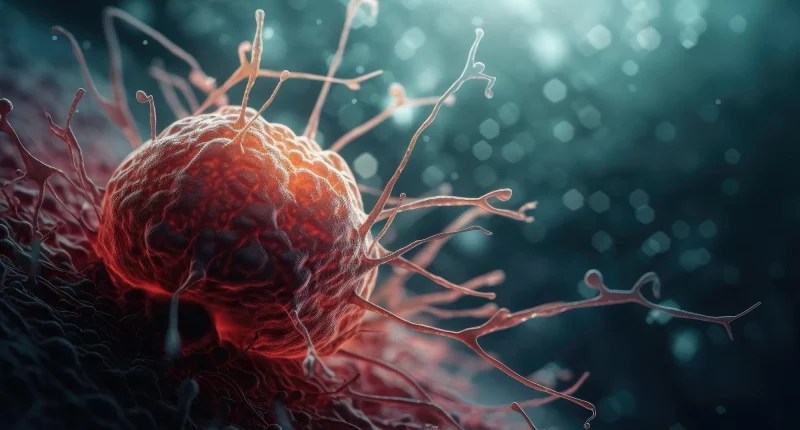Adenocarcinoma is a kind of cancer that starts in glands. Glands are special parts of the body that make or release stuff inside or outside the body. The signs of an affected person may vary and rely on the location and size of the tumor
What happens next, how it’s treated, and how likely it is for someone to get better all depend on where the tumor is, how big it is, and how far along it is, as well as how healthy the person is overall.
Types
There’s a type of cancer called adenocarcinoma that starts in glands but can spread to other parts of the body.
Here are some places where adenocarcinomas often happen:
- Lung: Almost 40% of lung malignancies are adenocarcinomas. They start in new mucus-making cells in the lungs.
- Breast: The maximum number of breast cancers are adenocarcinomas. They usually start in the milk ducts or the secretors that make milk.
- Prostate: Adenocarcinoma of the prostate starts in the prostate gland cells. Most prostate cancers are of this type.
- Pancreas: These Pancreatic adenocarcinomas happen when certain cells in the pancreas develop too fast. About 95% of pancreatic cancers are of this type.
- Colon: Most of the colon cancers are related to adenocarcinomas. They start in the glands that make mucus to line the rectum and colon.
Sometimes, the brain can also get an adenocarcinoma. This usually happens because cancer cells have spread there from other parts of the body.
Symptoms
Symptoms of adenocarcinoma vary depending on where it occurs in the body, so there’s no single list that fits all cases.
Lungs
In the lungs, adenocarcinoma might cause coughing, having an abnormal voice, blood in mucus, losing weight without trying, fatigue, and extreme tiredness.
Breast
When adenocarcinoma develops in the breast, it often presents as a lump or an abnormal growth.
Prostate
Prostate cancer usually doesn’t show symptoms in its early stages. But as it progresses, adenocarcinoma of the prostate can lead to pain during urination, problems with bladder control, more often nighttime urination, bleeding in the semen, and painful discharge.
Pancreas
Pancreatic Adenocarcinoma often brings losing too much weight, along with pain in the stomach and back, oily and pale stools, and skin itching
Colon
When adenocarcinoma affects the colon, symptoms may include feeling like the bowels are full, blood in stool or rectal bleeding, stomach ache, and losing weight.
Skull
In cases where adenocarcinoma grows in the skull, symptoms can manifest as headaches, nausea, throw up, seizures, blurry vision, mood swings, uncommon sensations in the arms or legs, changes in thinking, changes in personality.
Causes and Risk Factors
Adenocarcinomas develop for various reasons, and scientists are still trying to understand why some people develop these cancers while others do not. However, several risk factors are known to increase the likelihood of developing adenocarcinomas. A family history of cancer and exposing to radiation therapy are common risk factors for many types of adenocarcinoma.
Lungs
The primary risk factors for lung adenocarcinoma include tobacco smoking and exposure to second-hand smoke. Other risk factors are disclosure of harmful chemicals in work or home environments and prior radiation therapy, especially targeted at the lungs.
Breasts
Key risk factors for breast adenocarcinoma include being female, as women are more likely to develop breast cancer than men, and older age, as the risk increases with age. A family history of breast cancer, genetic factors, and the use of hormone replacement therapy (HRT) also significantly increase the risk.
Prostate
Risk factors for prostate adenocarcinoma include age, with a significant increase in risk after age 50. Ethnicity and Race also play a role, as prostate cancer is more common in Caribbean men of African heritage and African American men. Geography is another factor, with higher rates observed in Australia, North America, the Caribbean, and northern Europe. Having a close relative with prostate cancer doubles the possibility.
Pancreas
Risk factors for pancreatic adenocarcinoma include cigarette smoking, being overweight or obese, disclosure to certain chemicals used in dry cleaning and metalwork, and older age. Men are more likely to develop pancreatic cancer than women.
Colon
Several factors increase the risk of adenocarcinoma in the rectum and colon. These include being overweight or obese, leading an inactive lifestyle, eating a diet high in processed meats and red meats, smoking, consuming excessive amounts of alcohol regularly, having a history of irritable bowel disease, and type 2 diabetes.
Brain
Adenocarcinoma can spread to the brain, and certain factors increase this risk. Exposing to radiation, often as part of other cancer treatments, is one such factor. A family history of cancer-related diseases, like Li-Fraumeni Syndrome, also raises the risk. A 2018 study published in the Chinese Neurosurgical Journal found that people below 60 years old with lung adenocarcinoma that has extended to the lymph glands are at a higher chance of brain metastasis.
Diagnosis
Diagnosing adenocarcinoma typically starts with a thorough examination and taking a detailed medical history. The healthcare provider will inquire about the individual’s symptoms and potential risk factors, for example, smoking habits and family history of adenocarcinoma.
To diagnose adenocarcinoma, the healthcare provider may use several tests, and often, multiple tests are needed to confirm the diagnosis. These tests can include the following options:
- Imaging Tests: X-rays, CT scans, MRIs, and PET scans can help visualize tumors and assess their size and spread.
- Biopsies: Taking a sample of tissue from the suspected tumor site for microscopic examination to confirm the presence of cancer cells.
- Blood Tests: Checking for specific markers that might indicate cancer.
- Endoscopy: Using a flexible tube with a camera to view areas inside the body and collect tissue samples.
Each of these tests provides different information that helps in diagnosing adenocarcinoma accurately.
Treatment
Treating adenocarcinoma relies on where the cancer is located, size of the tumor, and whether it has extended to other parts of the body. The healthcare providers also consider the overall health of the patient, as treatments can have severe side effects.
Surgery
One common treatment is surgery to remove the tumor. The safety and effectiveness of surgery can vary depending on the type of cancer and its location. For example, removing a breast tumor (lumpectomy) is comparatively safe, but removing a brain tumor can be dangerous. In cases of adenocarcinoma that is likely to spread rapidly, surgeons might remove an entire gland or organ.
Chemotherapy
Chemotherapy involves using medication to kill cancer cells. This can be done by injecting the medicine into a vein with a needle or an IV drip, or by taking the drugs orally. While chemotherapy is effective in killing cancer cells, it can also harm healthy cells. This can lead to side effects such as nausea, hair loss, fatigue, and other issues.
Targeted Therapy
Targeted therapy uses drugs that specifically attack cancer cells. These drugs may be used instead of or in addition to chemotherapy, depending on the type of cancer and the patient’s health.
Radiation
Radiation therapy uses high-energy waves to destroy cancer cells. It can be delivered externally from a machine or internally by placing a device near the tumor. Like chemotherapy and radiation can also damage healthy cells and lead to significant side effects.
Immunotherapy
Immunotherapy uses medications to help the immune system fight cancer. While these drugs may not fully destroy cancer, they can prolong life and often have fewer side effects than radiation or chemotherapy.
Summary
Treating adenocarcinoma depends on the cancer’s location, size, and spread, as well as the patient’s overall health. Common treatments include surgery, chemotherapy, targeted therapy, radiation, and immunotherapy, each with specific uses and potential side effects. Surgery removes tumors and possibly lymph nodes, while chemotherapy and radiation kill cancer cells but can harm healthy cells. Targeted therapy and immunotherapy offer more specific approaches with varying effectiveness and side effects.









